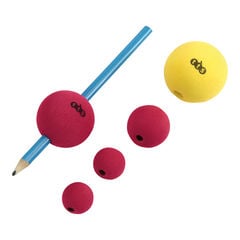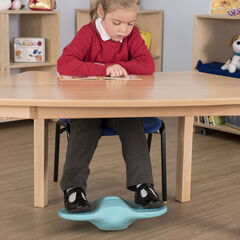Handwriting is undoubtedly an important, but complex skill which takes several years to acquire.
In our FREE Handwriting Download, Alison Harris, Occupational Therapist, explores and offers practical advice for ways to support children with 6 essential aspects for handwriting.
In this blog, we share a few snippets of advice from each of the 6 articles which can all be read in full in our Handwriting magazine.
1. Readiness to Write
I know that this will be relaying information that you are already aware of – but – not every child is ready to start writing. We are not talking about the ability to construct and relay a story – but readiness for the physical task of handwriting. You will be aware that some children find writing much harder than others but have you stopped to evaluate why that is?
Handwriting is a complex task and one that we present to very young children. We get a lovely chunky pencil in their hand, use great multi-sensory strategies and get started. But let’s stop and consider this a little bit more? Not just in terms of Early Years and KS1 children, but also older children with special educational needs.
Do you think a child needs to be able to:
- Have enough postural control to sit on the seat without consciously thinking about it?
- Have an established dominance and not be frequently swapping hands for the task?
- Understand your verbal instructions around spatial elements of writing? (Start at the top, go around, below the line and so on)
- Use working memory to retain new information?
- Copy your demonstrations of how to form letters?
- Use motor memory to remember how the letter formation feels?
- Use effective eye-hand coordination?
The answer is “yes” to all the above. But there’s also more!
Time put in now working on all the underpinning skills such as core stability, shoulder strength, eye hand coordination, spatial skills through movement and motor memory development can make a huge difference to a child’s handwriting and longer term to even making a difference in their attainment.
It really is worth stopping and working on NOW.
Read Alison's full article in our Handwriting Magazine
If you want more information about “Readiness to Write” – have a look at “Start Write, Stay Right” where there is a checklist that you can use with any child. This is a great resource to use with pupils as a whole class, or in a small group with a teaching assistant. You may well be surprised how many children struggle with these basics.

2. Equipment and Environment
There is so much pressure on teachers to work through the curriculum, and to check that some children are not getting left behind and others are sufficiently stretched. It can feel like there is little time to work on the mechanics of handwriting but time spent on this is so worthwhile!
Avoiding glitches now can reduce the impact of bad habits literally for a lifetime. Input does not need to be time consuming, but it does need some preparation when thinking about the environmental challenges and what equipment to use.
From finding the right posture supporting chair and using writing slopes to paper position and choosing a pencil grip or writing tool, Alison shares her advice for using the right equipment to support children as they develop their handwriting.
Read Alison's full article in our Handwriting Magazine
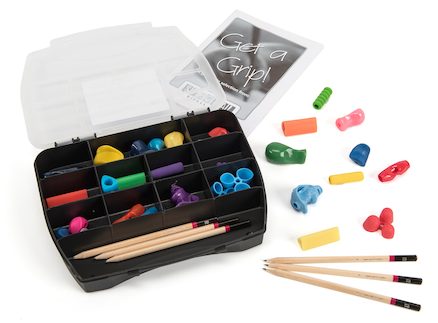
3. Hands and Eyes
Effective eye hand coordination is part of the building blocks towards good handwriting. Remember though that posture, shoulder stability and basic fine motor skills need to be addressed first!
At the risk of repeating this (not really apologising for this CRITICAL point!) this is the way skill development works, like building a wall – brick next to brick, layer upon layer, making firm foundations for the higher skills aimed for.
Additional help for fundamental eye hand coordination skills can help build children’s self-esteem and belief in their ability to produce work which they are proud of.
In this article, Alison explores the different activities and resources that offer support from hand strengtheners and finger fidgets, to curly wurly pictures and complete programmes.
Read Alison's full article in our Handwriting Magazine
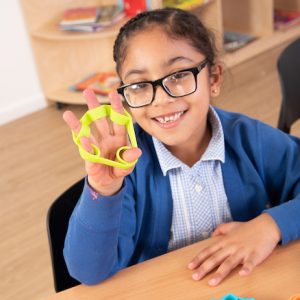
4. Teaching Left Handers to Write
First things first, sitting space and position of the paper are the first elements of helping a left hander to produce their best work. Left handers need to sit on the left, so that there is space by their left elbow and they are not getting into elbow wars with their right handed neighbour.
Have you noticed how many left handers end up with a very awkward hook grip? They do this to enable themselves to see what they are writing and not cover it with their hand.
This is the result of poor positioning of both the paper and hand and can lead to reduced fluency in the handwriting. It also means that they are having to work hard not to smudge and drag the pencil or ink so that their work becomes messy. It really does not have to be that way and is easily eradicated by teaching them to position their paper in a way that works best.
Read more of Alison's advice on positioning, support and equipment
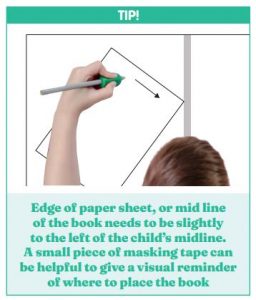
5. Fluency and Automatic Writing
The long term aim when teaching handwriting is to enable children to write legibly, automatically and with minimal fatigue. This requires so many foundation skills to be in place including hand dominance, letter formation, working memory and many more.
In this section, we focus on the automaticity of handwriting skills.
This requires the child to:
- Maintain a good postural position and be able to give their full attention to the cognitive task (research shows that when a child has postural instability, this takes away ‘brain energy’ from the learning task and means their attention is affected negatively).
- Be able to coordinate their eyes and writing hand without conscious thought.
- To be so familiar with letter formation (and cursive joins) that they do not need to consciously form a plan or motor sequence in order to write.
The benefits of achieving fluency in handwriting are many. Time and effort for pupil and teacher alike is reduced if pupils are specifically taught rather than just picking it up and having to correct errors later. Fluency also goes hand in hand with literacy as pupils can focus on the content rather than the motor action of writing.
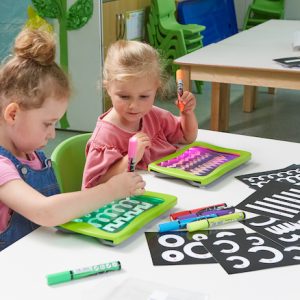
6. Confidence and Motivation for Writing
Our handwriting is definitely something that we are either rather pleased about and feel that it is pleasant to read, or at the other end of the spectrum, we avoid it as much as possible or make apologies for it! For children, it can be a real issue affecting their self-esteem too.
You will be aware that some children really dislike it and so try and reduce the amount they write. They therefore do not actually produce the work that they are cognitively able to do.
So, our approach as supporting adults needs to take confidence about writing seriously and to consider how we can help children to develop their self-esteem about the work that they produce on paper.
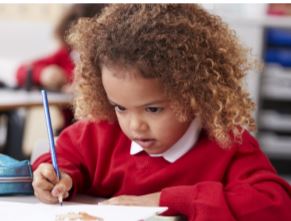
Firstly, be aware of the children in your class who are not keen or who feel their writing is not very good. Is there disparity between what they produce on paper with what you know they know?
Secondly, it is important to evaluate if there are difficulties with posture, eye hand coordination, remembering letter formation or visual difficulties.
And finally, have you considered the sensory aspects of handwriting? The need for sensory movement breaks to prepare the children to be well regulated and able to sit and focus? Movement increases our proprioception which is our body awareness and ability to grade the movement of our muscles. Improving proprioceptive feedback and helping the children to be in their best calm, alert state is also an essential foundation for handwriting.




